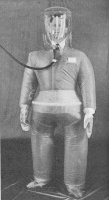
The pressure suit has helped humankind achieve some of its most spectacular feats, whether it be discovering the depths of the ocean or exploring the hostile environment of space.
It’s unfortunate then that during these periods of major historic significance, no one has been able to come up with a suit that is more flattering than the one pictured.
The problem has always been overheating and mobility. The image above comes from The Engineer’s 1954 archive and shows a design of plastic clothing created by Bletchley-based Plysu Products.
At the time, the suit was used by the atomic energy establishments at Harwell and Windscale to protect their employees against radioactive dust and particles. Made from PVC sheet, all seams in the suit were electronically welded to ensure they were air-tight.
’The top of the clothing consists of a jacket and integral transparent hood, the lower half combining trousers and overboots. The two halves button together at the waist and are sealed by a two-inch wide strip of ’Cellophane’ tape,’ said the report.
Register now to continue reading
Thanks for visiting The Engineer. You’ve now reached your monthly limit of premium content. Register for free to unlock unlimited access to all of our premium content, as well as the latest technology news, industry opinion and special reports.
Benefits of registering
-
In-depth insights and coverage of key emerging trends
-
Unrestricted access to special reports throughout the year
-
Daily technology news delivered straight to your inbox










UK Enters ‘Golden Age of Nuclear’
The delay (nearly 8 years) in getting approval for the Rolls-Royce SMR is most worrying. Signifies a torpid and expensive system that is quite onerous...